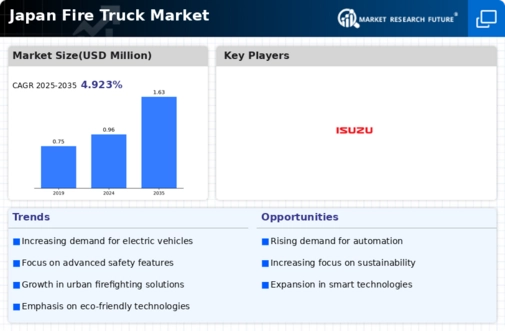The competitive landscape of the Japan Fire Truck Market is characterized by a mix of established manufacturers and innovative newcomers. The market reflects a blend of traditional firefighting equipment with modern technological advancements aimed at enhancing safety and operational efficiency. This sector is primarily driven by local government budgets, urbanization, and the increasing demand for advanced firefighting solutions.
As emergency response needs evolve, companies are continuously enhancing their products, fostering competition that fuels innovation in the field. Key players in the market are focusing on meeting stringent regulatory standards while also exploring partnerships and collaborations to strengthen their market presence and expand their product offerings. The emphasis on quality, reliability, and adaptability in fire truck design is pivotal, influencing consumer purchasing decisions while shaping the operational capabilities of firefighting agencies across Japan. Suzuki Motor Corporation has carved a notable presence in the Japan Fire Truck Market through its commitment to quality and innovation.
Though primarily known for passenger vehicles, Suzuki has strategically diversified into the fire truck segment, emphasizing compact, efficient design tailored for urban settings. The company’s strengths lie in its ability to produce versatile small fire trucks that cater to the needs of both municipal fire services and industrial applications.
The integration of advanced safety features and ease of maneuverability distinguishes Suzuki from competitors, enhancing its appeal within the public safety sector. Additionally, the company benefits from a well-established distribution network and strong brand loyalty, enabling it to respond swiftly to market demands and regulatory changes. This strategic positioning allows Suzuki Motor Corporation to sustain competitiveness within the dynamic environment of the fire truck market in Japan. Hino Motors, Ltd. stands as a formidable contender in the Japan Fire Truck Market, recognized for its robust trucks that meet a variety of emergency response needs.
The company’s portfolio includes a range of fire truck models designed for different operational scopes, from urban firefighting units to specialized vehicles equipped for disaster response.
Hino’s strengths include its deep expertise in commercial vehicle manufacturing and a commitment to integrating advanced technologies, such as hybrid and alternative fuel solutions, which appeal to contemporary fire services seeking sustainable operation. This commitment is reflected in collaborations for co-developing fire-fighting vehicles with local authorities, optimizing response times, and enhancing firefighting capabilities.
Hino Motors has also strategically pursued mergers and acquisitions to bolster its technological prowess and expand its service offerings, which has reinforced its market position within Japan. By focusing on innovation and partnerships, Hino Motors, Ltd. continues to adapt and thrive amidst the evolving demands of Japan's fire service landscape.











